Stillborn monsters
At first glance, this was the usual boastful chatter about "miracle weapons", which in recent months was repeated in all ways with Hitler's propaganda. However, in London, Goebbels’s statement suddenly alarmed: this time the Nazi minister spoke about the enemy’s presence of “in all areas of the war”! Even if this was an exaggeration, it was still necessary to sort everything out seriously in order to foresee the possibility of any unpleasant novelties in the field of armaments for the Hitlerites.
On Churchill’s personal order, members of the Scientific and Technical Intelligence Committee were urgently assembled, which included such eminent scientists as Professor of Ballistics Jones, closest advisor to the British Prime Minister, Professor of Physics Lindeman, renowned expert on military technology issues Sir Arthur Ellis, and high-ranking military. Opinions of the committee members are divided. Some thought that the statement that made the noise was just another bluff. Others, on the contrary, argued that the Nazis were preparing some surprises.
Indeed, there seemed to be good reason for the second point of view. It was far from the first time that threats were heard from Berlin to use the "terrible weapon of retaliation." And what? On June 16, 1944, the first V-1 projectile was launched on London, after which hundreds of these flying bombs, each filled with a ton of explosives, hit England every day. Allied soldiers! - the Nazis wrote in leaflets, with which they literally bombarded the British and American troops that landed in France. “You have fallen into a trap... You are fighting on a narrow strip of land, the area of which was predetermined by us. Meanwhile, our planesRobots sow death and devastation in cities and harbors, from where you obtain ammunition, food and equipment. Your communications have been cut…” “Now it can no longer be considered bragging by the statement of the competent German authorities that the use of ... new German weapons was only the beginning, one should reckon with the upcoming expansion of their use,” scientific observers said in the press. Their predictions came true: on September 7, a V-2 rocket was used against England.
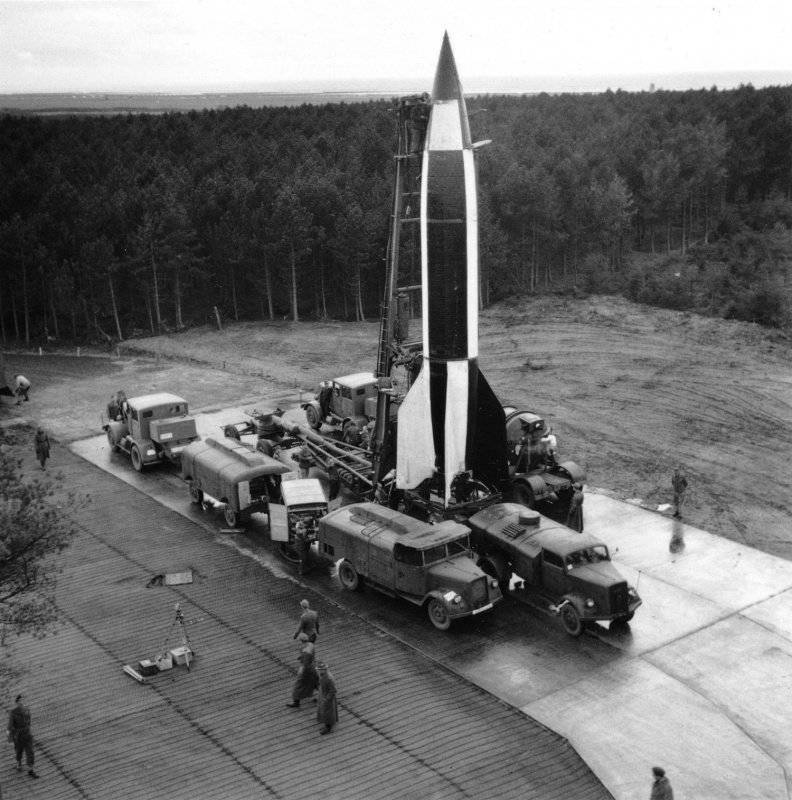
The reflection of Hitler's missile strike required considerable effort from the British. An ad hoc air defense coordination committee was created under the cabinet of ministers, led by Churchill's son-in-law, Lt. Col. Sandis. The commander of the fighter was subordinated to the committee. aviation Marshal Hill, vice marshal Gell, head of the barrage balloon network, and General Pyle, anti-aircraft artillery commander. Only to cover London in a small area between the city and the coast were concentrated 1800 guns and 2 thousand balloons. Almost round the clock pilots and anti-aircraft gunners waged exhausting battles, shooting down aircraft-shells. But if these measures were effective against the V-1, flying slowly and at low altitude, then, as General Pyle later admitted, the UK did not have satisfactory anti-ballistic defense systems before the end of the war to combat the V-2. As a result, Hitler’s shells and missiles killed and wounded about 35 thousand British, destroyed a huge number of buildings.
Alas, all this was calculated only after the war. But then, in the autumn of 1944, British intelligence officers, scientists and specialists were painfully trying to answer the alarming question: are there any effective new weapons in the arsenal of Hitler’s command? At that time, the answer given was never. Moreover, when, after the capitulation of Germany, the secret materials of the Nazi research institutes, military centers, and various firms fell into the hands of the allies, they were hidden for seven years in seven offices in the relevant institutions of the United States and England. It was then that the myth was born in the Western press that Hitlerite Germany allegedly had all sorts of super-fantastic weapons in its destructive power, and if she used it in time, the Second World War would have been won by her. “The Germans had hundreds of projects of secret weapons,” writes American Bert, “which our specialists were amazed to see when studying the Nazi archives after the war.” And only the lack of coherence and coordination between the three types of armed forces, in his opinion, prevented the emergence of new weapons on the battlefield.
It sounds, no doubt, quite mysteriously and, perhaps, to some degree fascinating. Still, in top-secret laboratories, on testing grounds hidden in mountains and forests, some unknown geniuses develop and experience something that the world does not even suspect. Maybe tomorrow, well, in a month or two this mysterious thing will be thrown into battle and ... But the reality turned out to be much more modest and prosaic.
Among the three types of armed forces in the development of experimental weapons systems in the first place were the Nazi Luftwaffe. In particular, their designers proposed the original model of a fighter under the conditional name “Bomberszeg” - “a saw for bombers”. By the summer of 1943, the Hitlerites had trumpeted to the whole world about "outstanding achievement" in the field of aviation - the heavy Focke-Wulf-190 fighter armed with four guns. However, in air battles, he could not resist the Soviet "Yakam" and "Lavochkin", although he added two more firing points, set the front and bottom armor. The car turned out too heavy and non-maneuverable. Meanwhile, massive allied bombing raids on Germany itself began, in which hundreds of “flying fortresses” took part. Focke-Wulfam was unable to cope with them.
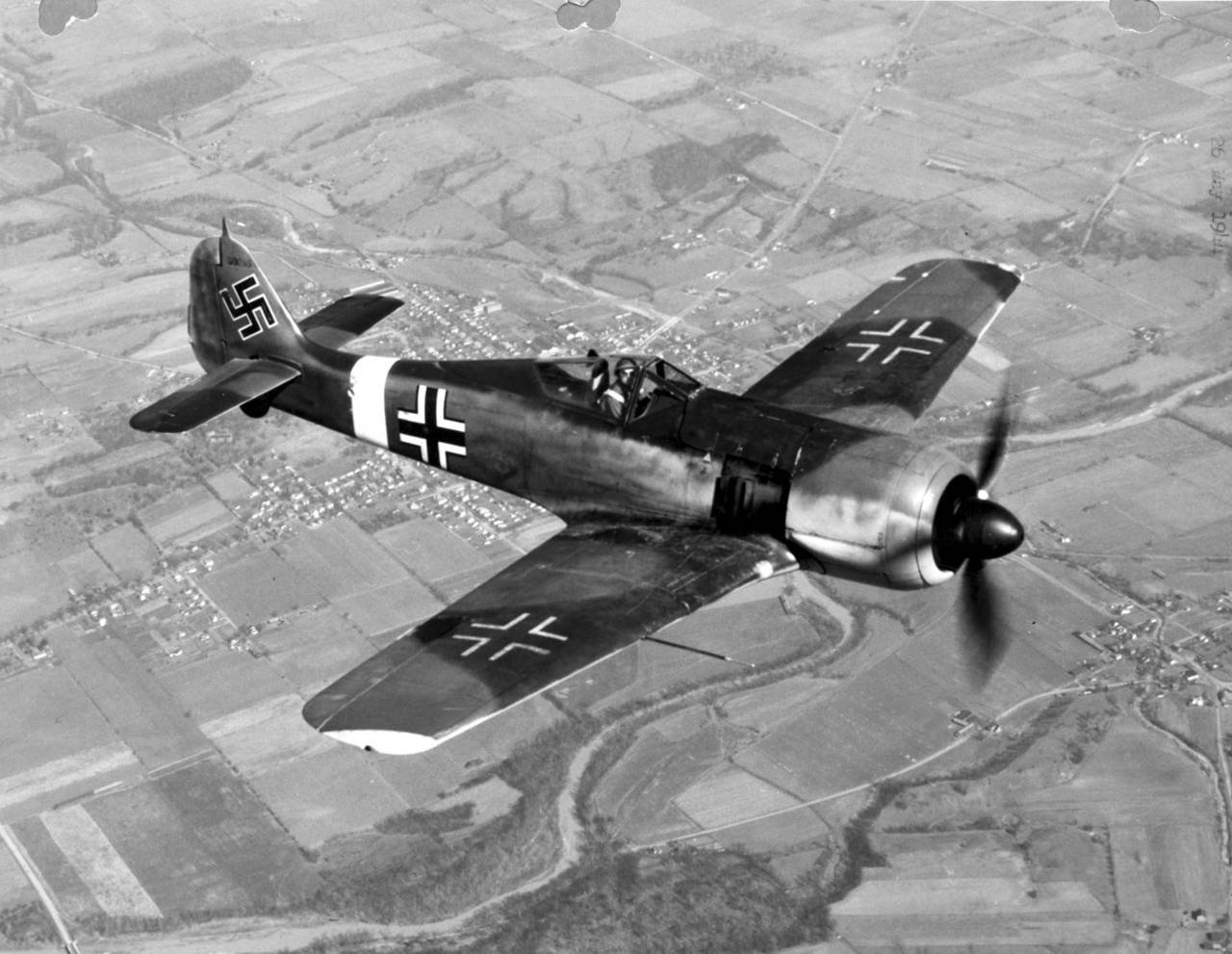
It was then that the intensive development of the "saw" began. The German designers proceeded from the fact that the bomber’s most vulnerable spot was the lower part of the fuselage. It is enough to install several guns in a vertical plane on a fighter plane, they believed, and the result would be an ideal weapon against “flying fortresses”. The pilot will just have to fly under the belly of the enemy plane and press the trigger. In practice, the matter turned out to be much more complicated. Serial aircraft cannons in firing from such an unusual position gave too many blunders, but the Focke-Wulf itself lost any chance of success in the event of a fight with enemy fighters.
Hitler's experts tried to replace aircraft guns with recoilless, small-caliber guns. But even here they failed. It became absolutely clear that, with all its seeming originality, the idea of vertical placement of weapons in the fuselage of a fighter is simply a design dummy. True, by the end of the war, work was underway on another “killer of bombers” under the frightening name “natter” - “viper”. Its prototype was supposed to serve as a manned aircraft projectile "V-1". It was planned to install 24 missiles in the nose of the “natter”. Launched from a launcher, he could, within four minutes, almost vertically gain altitude, and, firing rockets on the target, plan on the landing pad. The designers, alas, did not take into account the main thing: even if they had managed to create combat samples of "vipers", they would not be destined to become an effective weapon for fighting bomber because of an extremely small radius of action and a complete lack of maneuverability.
Meanwhile, the power of the Allied raids on the cities and factories of the Nazi Reich was steadily increasing. During each of them they dropped approximately 2-3 thousand tons of bombs weighing 2, 3, 5, and at the end of the war - to 10 t. The air defense of the Nazis clearly lost the battle with the American and British aircraft, while on the East To the front, Soviet attack aircraft and bombers inflicted sensitive losses on Wehrmacht troops. The Fuhrer and his high command categorically demanded that the Nazi gunsmiths at any cost create new types of anti-aircraft weapons, but neither thunder and lightning, sparkling at meetings at the Fuhrer's headquarters, nor generous promises to inventors and industrialists could not get the German design idea out of the deadlock. The only thing that came to the armament of the air defense units by the end of the war was the “backlash” - the “air fist” - and the “kurtzzeit sperr”, which had no effect on the course of the hostilities.
“Kurztsayshsprere” - “short-term barrage” - was relatively simple in its design. A solid ring of rockets was placed around an important object at a distance of 25 meters from each other. When the enemy bomber approached, the missiles were simultaneously launched into the air and at the height of 1000 m exploded, leaving small parachutes in the sky that were connected to the ground with steel cables. Theoretically, the “kurtstsay shperre” was supposed to form a continuous irresistible fence around the defended object, but in practice it turned out to be a short-lived, semi-handicraft idea, actually copied from an airborne balloon. The creators of this "miracle weapon" did not take into account that planes can easily reach the object above the "fence". Moreover, the "miracle weapon" itself was kept in the air only in calm weather. Even a small gust of wind blew the parachutes to the side or nailed them to the ground.
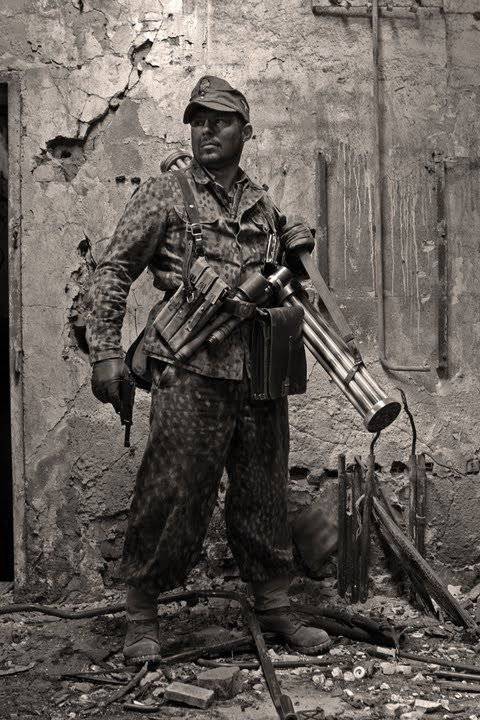
Luftfaust was more original. In this case, the German gunsmiths tried to create a light anti-aircraft gun by joining nine 20-millimeter bazookas together. The fire from it was conducted by one person right from the shoulder. After pressing the trigger, the electric ignition device ignited the charges of the first five missiles, and after a tenth of a second - the remaining four. As a result, the missiles simultaneously went to the target with a kind of flock and did not knock each other out of a given direction with the exhaust of burnt gases. But the "air fist" had one major drawback - its missiles could hit planes at a height of no more than 500 m.
Curious story attempts to design and build a super-powerful artillery gun, the firing range of which exceeded 100 km, something like an improved “big Bertha” that shelled Paris during the First World War. The first project of such a tool called the “long Gustav” was developed in the Krupp concern. The caliber of the gun was equal to 600 mm, and the weight of the projectiles was to reach 7,5 t. According to calculations, it was able to send its super-shells at a distance of 120 km. The project was reported to the Fuhrer himself by the Minister of Arms and Military Industry Speer and received his approval. But when specialists from the Army Armaments Directorate sat down to check the calculations, it turned out that the authors of the “long Gustav” showed amazing engineering illiteracy. If such a weapon were built, its weight would be equal to 1500 t. None of the existing gun carriages would have sustained it, and the barrel itself would have failed after 50-60 shots.
"Long Gustav" was rejected, but the idea of super-arming was still seriously considered by Hitler’s weapons experts. And not only as a purely theoretical problem, but also as a practical task that can be solved at a given level of development of artillery equipment. It was taken over by the engineer Walter Kenders, who worked in the improvement department of the Wehrmacht’s main armaments department. He believed that the difficulty with the carriage can be circumvented by generally abandoning it. It is much easier to place the barrel of a cannon in a concrete shaft and give it a constant angle of elevation. Of course, in front-line conditions such a gigantic weapon will bring little benefit, but it could be used to fire a fairly large fixed target, such as, for example, London. The second innovation proposed by Kenders for his “tousendfuss” - “centipedes” was multistage combustion chambers located along the entire length of the barrel, which can gradually give the projectile the necessary initial velocity.
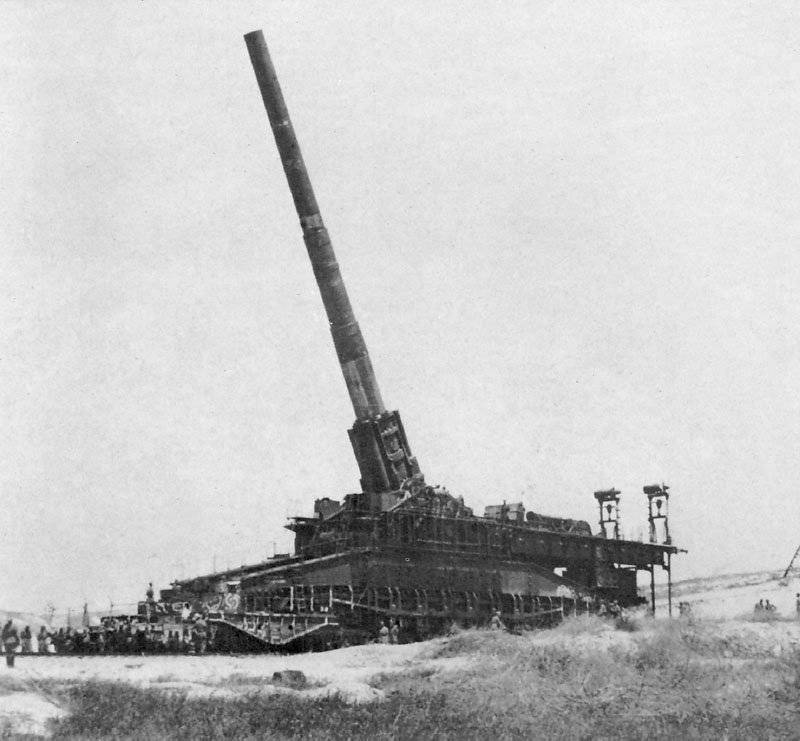
In the final form, the Kenders' centipede “captured the imagination with its fantastic courage: in 150-meter mines dug on the coast of France, barrels of giant 4,8-mm guns are assembled from 150-meter segments. 28 combustion chambers together with the main charge will throw a projectile out of the barrel at an initial velocity of 1500 m per second. Two batteries of such "centipedes", 25 guns each, will produce 600 shells per hour, bringing down explosives and Krupp steel to the target around 75.
Hitler, as soon as he was introduced to the project of Kenders, gave instructions to immediately begin the construction of the mines for the "centipede" in the area of Calais, not even waiting for the creation of a prototype tool and its tests. The order of the Fuhrer was executed, but the "Thousendfuss" did not open fire on London. When testing an experimental model of a reduced caliber, it was found that projectiles in flight deviate from a predetermined trajectory and tumble; combustion chambers often explode; in addition, when calculating the mines for the guns, a serious mistake was made - their inclination did not take into account the corrections for the Earth's rotation. And only tens of thousands of shells for the future "miracle guns" captured by the Allies, remained the material embodiment of the next failure of Hitler's designers.
However, as regards design absurdities, the Hitlerite sailors were not inferior to the artillerymen. They proposed a chemical composition that released a mass of gas bubbles in water. The idea was that the submarine found by the enemy surrounded itself with a kind of hissing veil and thus deprived the acoustics of the pursuing ships of the opportunity to follow its movement. Alas, in practice, the boat “hunters” combed the entire area of suspicious noises and covered with depth charges exactly the places where gas bubbles gurgled in the water. Vasseresel, the sea donkey, was no better. It was a trap ship, made in the form of a submarine and filled with explosives. Being underwater, the real submarine had to tow it behind him ... It was assumed that, having noticed a false submarine, the pursuing ship would try to ram it and be destroyed. In the event that he shot her with guns, his team would still consider the boat sunk and stop the pursuit. In practice, the trap vessel only betrayed its tugboat and deprived it of maneuverability.
In the last months of the war, in their search for new types of weapons, Hitler’s German design thought, figuratively speaking, of untrained youths from Volkssturm, who tried in vain to delay the offensive of the Soviet Army and Allied forces. In the Navy laboratories, they were worn with the idea of creating a special paint that would absorb the radar beam and make the technique painted by it invisible on the radar screen. The Luftwaffe feverishly developed a radio-controlled planning bomb, which the operator had the opportunity to visually output to the target.
Wehrmacht Colonel Shede, who spent most of the war in a psychiatric hospital, on the instructions of the Fuhrer tried to launch a cannon with a curved barrel, capable of firing from shelters at an angle of 30 ° or 90 °. Submariners struggled in vain to set up ten torpedo tubes on boats with a fan and hit several targets at once with one volley. The von Braun fighters attempted to upgrade the V-2, half of which did not reach the target, exploding at launch or falling into the sea during the flight. But it was too late. The Wehrmacht of Hitler and the design idea of the Third Reich lost the war. As the West German historian Ludwig Müntzinger later wrote, "new, still immature types of weapons would still not be able to bring about a change in the course of military actions."
"Darning Holes"
Article "Stillborn Monsters" commented engineer Boris Kornev
When Kaiser Germany defeated France in 1870, all victories were attributed to the high morale and fighting qualities of the German soldier. It was then that Bismarck uttered his famous phrase that the battle at Sedan was won not by guns and guns, but by a German school teacher.
But it turned out that the Franco-Prussian war was the last victory of Germany, followed by a defeat in the imperialist war and a crushing defeat in the Great Patriotic War. But if the indecisive outcome of the First World War gave the German revanchists the opportunity to create a legend that the Reichswehr had never been defeated in open battle, that he had failed because of the betrayal of the socialists, who had stabbed the army in the back, how could the catastrophic defeat of Hitler’s military and state machinery in the Great Patriotic War be explained? To recognize the superiority of the Soviet ideology, the superiority of the socialist system, the superiority of the Soviet military art and the fighting qualities of the Soviet soldier - such a path turned out to be unacceptable for broken fascist warriors. And then a myth arises: Germany lost the war only because its military equipment was worse than American and English.
The grounds for such statements did not have long to search. For example, English General Fuller, author of the book “Influence of Weapons on History”, argued: “Victory by 99% depends on military equipment or on weapons ... Strategy, command, military leaders, courage, discipline, supply, organization, and all physical or moral the apparatus of war is nothing compared to the great superiority in the field of armaments ... All this, taken together, is no more than 1%. ” Therefore, the Fuhrer's unlucky successor, Admiral Doenitz, quickly found the cause of his failures: "The enemy won success in the submarine war not by superior strategy or tactics, but by superior technique ..."
At the beginning of the war, Hitler, confident of the superiority of his war machine, forbade financing all new technical developments, the completion dates of which were over a year. But as this military machine was milled on the fields of Russia, the Fuhrer and his generals began to become uneasy, and their thoughts more and more often began to return to the “miracle weapon” that could change the whole course of the war at once. But, alas, the words that the head of the German general staff, F. Halder in January 1942, described the situation on the Eastern Front: “Darn holes! You should not expect success. ”
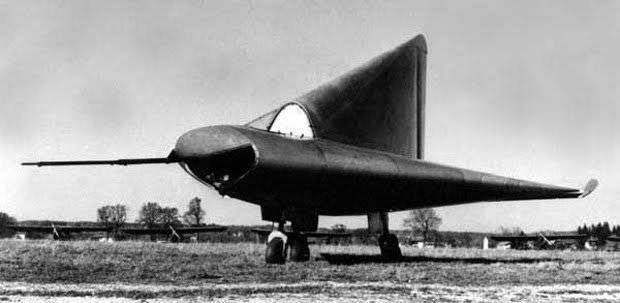
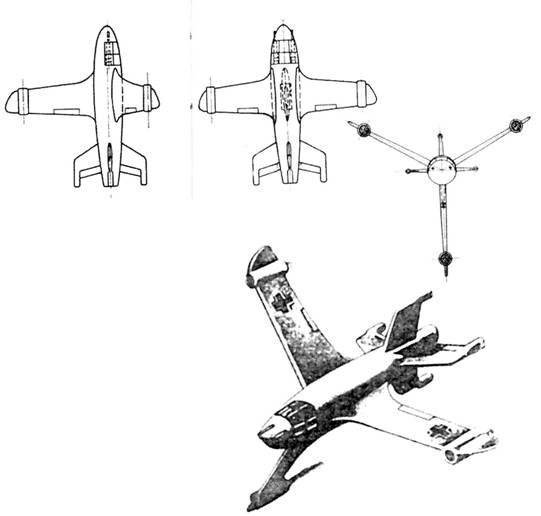
S. Milin, the author of the article “Stillborn Monsters”, collected curious material about the ideas and projects that German designers frantically developed at the end of the war. The author is right: no "miracle weapon" could save a "thousand-year-old Reich" collapsing under the blows of the Allied armies. But, focusing only on technology, considering it in isolation from economic and production conditions, the author, unfortunately, gives technical ideas not always a correct assessment, and he turns out to be lumped together as obviously idiotic projects like “Kurtzitsaitsperre” and “ vasesesel, ”and fundamentally benign ideas, for which the Germans simply did not have time to refine, for example,“ backlash ”and“ natter ”.
It is well known that it is impossible to create a structure that lacks flaws and is capable of performing any task. The most famous examples of military equipment can be easily discredited by setting them tasks for which they were not intended. From this point of view, it is impossible to consider the lack of “backlash” the fact that its missiles could not hit planes flying more than 500-meter in height. After all, this weapon was born as a response to the appearance of parachuted bombs that allowed Allied airplanes to bomb from 75-100 m. Similarly, the short range and lack of maneuverability of the “natter” cannot be considered a serious disadvantage: for an interceptor hitting part of the airspace, these qualities are not essential. It is thought that the value of the anti-radar coverage for the cuttings and periscopes of the submarines, as well as the guided planning bombs, with which the Germans destroyed part of the Italian ships after Italy’s withdrawal from the war, are also incorrectly estimated. It is hardly possible to call a design dummy and work on installing recoilless guns on fighters, it was with the help of such guns that the allies destroyed all German coastal radio stations on the eve of the landing in Normandy.
The fact that the Germans did not succeed even in developing benign technical ideas was influenced by precisely those factors which Fuller considered insignificant: the rapid moral, political and economic collapse of fascist Germany simply did not give engineers any time for the design and technological development of new designs, and means for their mass production. And naturally, the focus of the Fuhrer and his circle shifted more and more into the sphere of chimerical ideas that promise the secret "miracle weapon".
In 1944, American military writer X. Miller in the article “What Will Replace tank"Emphasized, as he called," the four elements of war ":
1. Arms hands - melee weapons, explosives, toxic substances.
2. Hand lengthening - sling, bow, gun, gun, machine gun, plane.
3. The protection of the body of a warrior - a shield, helmet, armor, armor, reinforcement.
4. The psychological effect is the speed and suddenness of the attack, a new weapon that terrifies the enemy.
Looking at the possibilities of fascist Germany from the point of view of these "four elements", it is easy to see that by 1944, all its possibilities were exhausted and in no one point could it surpass the allies, except in the latter - a new weapon that terrifies its opponents.
Hitler’s adventurism didn’t affect with such fullness and brilliance as in this belated, desperate hope for the weapon of horror, the weapon against the civilian population. And this political adventurism entailed technical adventurism, design adventurism: all these Tauzendfussas and “fau”, pompously called retaliation weapons, turned out to be stillborn monsters, although the scientific principles laid down in them were not perverse. In essence, they were doomed at the moment when the decision was made to implement them, because the technician could not solve the tasks of politics.
Since the prehistoric man tied a stone to a stick and brought it down on the head of an opponent who was climbing into the fray with his bare hands, military experts have always sought to get a weapon in their hands that would have been a surprise to the enemy. In this sense, for the Germans, the truly secret weapon of the Second World War turned out to be not magnetic trawls, bazookas and even Allied radars, but those thousands of first-class airplanes, tanks and guns, those billions of bullets and projectiles that we produced in the war years, and finally, that combat all-conquering spirit and steadfastness of the Soviet soldiers who crushed the German military machine in the endless expanses of the Soviet country.
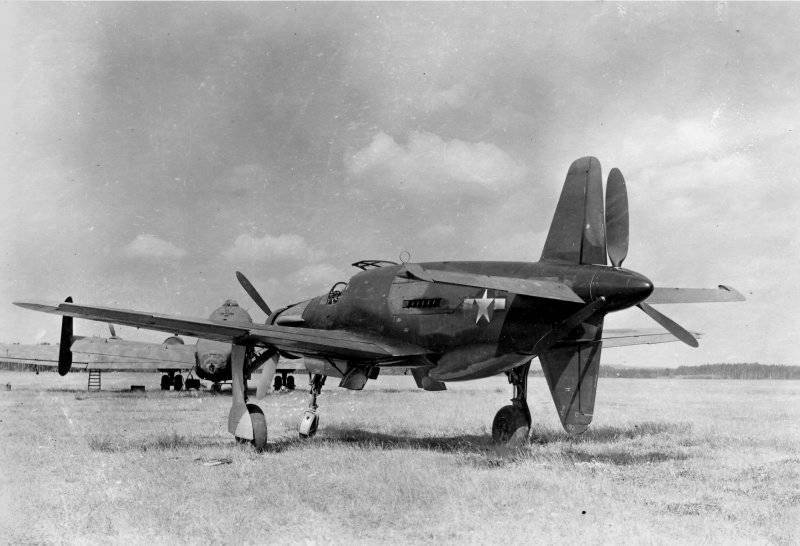
Information